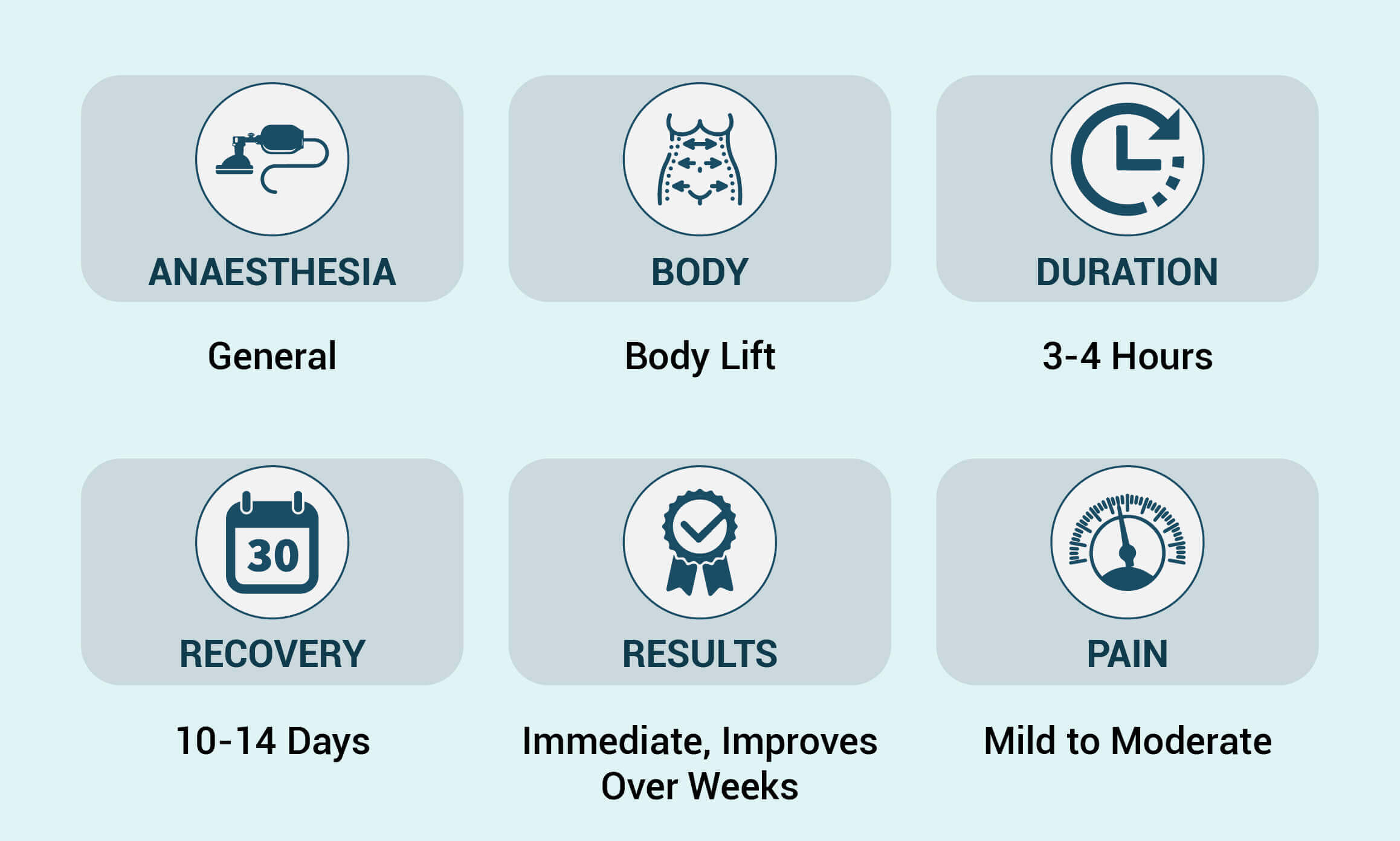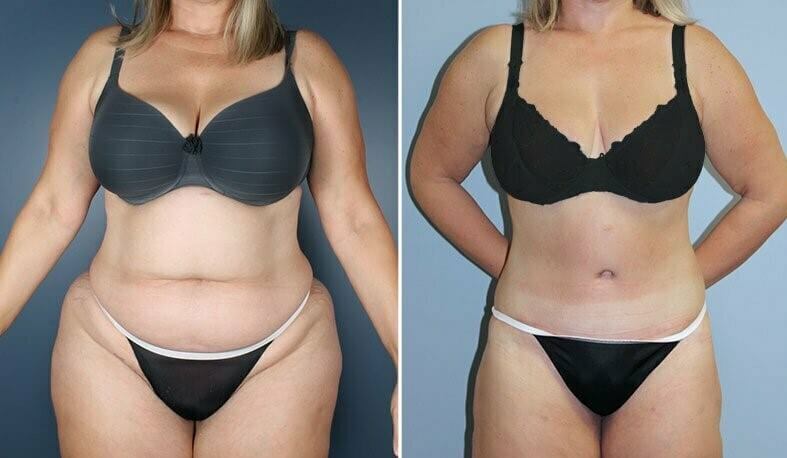Body Lift Surgery Treatment in Mumbai
Our skin loses elasticity and may begin to sag as we age. A body lift can help tighten loose skin and improve overall body appearance.
Dr. Vinay Jacob is a skilled plastic surgeon who performs body lift surgery in Mumbai. In summary, Dr. Vinay Jacob uses general anesthesia to perform body lift surgery treatment, making incisions around the lower body, removing excess skin and fat, and then tightening and suturing the remaining skin to create a more toned and contoured appearance.
To determine if body lift surgery is right for you and receive personalized recommendations, consult a qualified plastic surgeon.

What is Body Lift Surgery

If you have lost a significant amount of weight or have excess skin around your lower body due to aging, pregnancy, or genetics, you may consider lower body lift surgery, also known as a body lift.
This cosmetic surgery aims to remove excess skin and fat from the lower body, including the abdomen, buttocks, hips, and thighs, to improve the body's contour and create a smoother, more toned appearance.
Overview of the surgery :A body lift surgery combines several cosmetic procedures to reshape and trim away extra skin and fat from the patient's lower body, giving them a toned appearance.
Areas Of The Body covered:Thighs, butt and tummy
Body Lift Surgery Length Time:4-6 hours
Body Lift Recovery Time:2-6 weeks
Body Lift Preparation
Before undergoing a lower body lift surgery, you will have an initial consultation with your plastic surgeon to discuss your expectations, medical history, and any potential risks or complications associated with the procedure. To prepare for the surgery, you may need to:
1.Stop smoking, drinking alcohol, or taking certain medications that can increase the risk of bleeding or affect the healing process.
2.Follow a healthy diet and exercise regimen to optimize your body's condition and reduce the risk of complications.
3.Arrange for someone to drive you home and help you with daily activities during the recovery period.
Body Lift Surgery Procedure:
The lower body lift surgery typically takes several hours to perform under general anesthesia, and the exact technique used may vary depending on your specific needs and goals.
Some common types of body lift procedures include:
Circumferential Body Lift:
This involves removing excess skin and fat around the entire lower body, including the front, sides, and back, to create a more comprehensive improvement in body contour.
Thigh Lift:This focuses on removing excess skin and fat from the inner and outer thighs to create a smoother, more toned appearance.
Butt Lift:This involves lifting and reshaping the buttocks to create a fuller, more lifted appearance.
Tummy Tuck:This removes excess skin and fat from the abdomen and tightens the underlying muscles to create a flatter, more toned stomach.
Is Body Lift Surgery Safe?
Like any surgical procedure, lower body lift surgery has potential risks and complications, including infection, bleeding, scarring, and anesthesia-related complications. However, when performed by a board-certified plastic surgeon with extensive experience and training in body contouring procedures, the risks are generally low, and the results can be transformative.
Common Reasons Why You May Consider a Body Lift:
Some common reasons why you may consider a lower body lift surgery include:
1.Excess skin and fat after significant weight loss
2.Aging and skin laxity around the lower body
3.Aging and skin laxity around the lower body
4.Genetics and body shape concerns that cannot be improved with diet and exercise alone.
Lower Body Lift Surgery Length Time:
The length of the lower body lift surgery depends on the specific procedure being performed and the extent of the patient's concerns. However, it generally takes between 4-6 hours to complete the procedure.
Lower Body Lift Recovery Tips:
The recovery period after a lower body lift surgery can be lengthy, and it is essential to follow your plastic surgeon's postoperative instructions carefully to optimize your results and reduce the risk of complications. Some recovery tips include:
1.Wear compression garments to reduce swelling and promote healing.
2.Avoid strenuous activities and heavy lifting for several weeks after surgery.
3.Follow a healthy diet and stay hydrated to promote healing and prevent constipation.
4.Take prescribed pain medication as directed and attend all postoperative appointments with your plastic surgeon.
Lower Body Lift Recovery Time:
The recovery time after a lower body lift surgery varies depending on the patient's specific needs and the extent of the procedure. However, most patients can return to work and light activities within 2-3 weeks after surgery and resume more strenuous activities within 4-6 weeks
How do you sleep after a body lift?
A body lift is a major surgical procedure that removes excess skin and fat from various body parts, including the abdomen, buttocks, hips, and thighs. After surgery, your doctor will likely give you specific sleep instructions to ensure proper healing and minimize discomfort.
Here are some general tips that can help you sleep after a body lift:
Elevate your upper body:TKeeping your upper body elevated can help reduce swelling and discomfort. You may want to prop yourself up with pillows or a wedge pillow to elevate your head and shoulders while you sleep.
Sleep on your back:Your doctor may recommend sleeping on your back for the first few weeks after surgery to avoid putting pressure on the incisions and prevent complications. Place a pillow under your knees to help take pressure off your lower back.
Avoid sleeping on your stomach or side:Sleeping on your stomach or side can put pressure on your incisions and cause discomfort. Try to avoid these positions until your doctor says it's okay.
Use pain medication if needed:This involves lifting and reshaping the buttocks to create a fuller, more lifted appearance.
Butt Lift:This involves lifting and reshaping the buttocks to create a fuller, more lifted appearance.
Is Body Lift Surgery Safe?
Like any surgical procedure, lower body lift surgery has potential risks and complications, including infection, bleeding, scarring, and anesthesia-related complications. However, when performed by a board-certified plastic surgeon with extensive experience and training in body contouring procedures, the risks are generally low, and the results can be transformative.
Common Reasons Why You May Consider a Body Lift:
1.Some common reasons why you may consider a lower body lift surgery include:
2.Excess skin and fat after significant weight loss
3.Aging and skin laxity around the lower body
4.Pregnancy and childbirth-related changes to the lower body
5.Genetics and body shape concerns that cannot be improved with diet and exercise alone.
Lower Body Lift Surgery Length Time:
The length of the lower body lift surgery depends on the specific procedure being performed and the extent of the patient's concerns. However, it generally takes between 4-6 hours to complete the procedure.
Lower Body Lift Recovery Tips:
The recovery period after a lower body lift surgery can be lengthy, and it is essential to follow your plastic surgeon's postoperative instructions carefully to optimize your results and reduce the risk of complications. Some recovery tips include:
Wear compression garments to reduce swelling and promote healing.
Avoid strenuous activities and heavy lifting for several weeks after surgery.
Follow a healthy diet and stay hydrated to promote healing and prevent constipation.
Take prescribed pain medication as directed and attend all postoperative appointments with your plastic surgeon.
Lower Body Lift Recovery Time:
The recovery time after a lower body lift surgery varies depending on the patient's specific needs and the extent of the procedure. However, most patients can return to work and light activities within 2-3 weeks after surgery and resume more strenuous activities within 4-6 weeks
How do you sleep after a body lift?
A body lift is a major surgical procedure that removes excess skin and fat from various body parts, including the abdomen, buttocks, hips, and thighs. After surgery, your doctor will likely give you specific sleep instructions to ensure proper healing and minimize discomfort.
Here are some general tips that can help you sleep after a body lift:
Elevate your upper body:Keeping your upper body elevated can help reduce swelling and discomfort. You may want to prop yourself up with pillows or a wedge pillow to elevate your head and shoulders while you sleep.
Sleep on your back:Your doctor may recommend sleeping on your back for the first few weeks after surgery to avoid putting pressure on the incisions and prevent complications. Place a pillow under your knees to help take pressure off your lower back.
Avoid sleeping on your stomach or side:Sleeping on your stomach or side can put pressure on your incisions and cause discomfort. Try to avoid these positions until your doctor says it's okay.
Use pain medication if needed:Your doctor may prescribe pain medication to help manage discomfort during healing. Be sure to take your medicine as directed and only when required.
Follow your doctor's instructions: Your doctor may have specific instructions on how to sleep based on your individual needs and the type of body lift you have. Please follow these instructions carefully to ensure proper healing and minimize discomfort.
 WhatsApp
WhatsApp